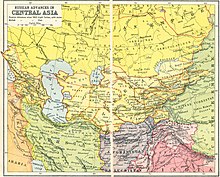
Back الغزو الروسي لآسيا الوسطى Arabic মধ্য এশিয়ায় রুশ বিজয়াভিযান Bengali/Bangla Russische Eroberung Turkestans German Conquista rusa de Asia Central Spanish Kesk-Aasia vallutamine Venemaa poolt Estonian حمله روسها به آسیای میانه Persian Conquête russe du Turkestan French Conquista russa dell'Asia centrale Italian Ресей империясының Орта Азиялық иеліктері Kazakh Russische verovering van Centraal-Azië Dutch
This article has multiple issues. Please help improve it or discuss these issues on the talk page. (Learn how and when to remove these messages)
|
| Russian conquest of Central Asia | |||||||||
|---|---|---|---|---|---|---|---|---|---|
| Part of the territorial evolution of Russia | |||||||||
 Map of Russia's advances into Central Asia, 1912 | |||||||||
| |||||||||
| Belligerents | |||||||||
|
|
Dzungar Khanate (until 1719) | ||||||||
| Commanders and leaders | |||||||||
|
List of Commanders
|
Abul Khair Khan Ablai Khan Sapura Matenqyzy List of Commanders
| ||||||||
| Strength | |||||||||
|
2,940 troops In 1717: 4,000 troops In 1715–1725: 2,000 troops 5 guns 12 pounds of gunpowder 300 cores 200 shot and buckshot charges In 1773–1775: 35,000 troops In 1832–1833: 1,050 troops In 1835: 3,347 troops In 1837: 3,080 troops In 1838: 2,620 troops In 1839–1840: 6,651 troops and 10,000 camels (Khiva) 2,600 troops (Kazakh Khanate) In 1843: 30,000+ troops (Summer) 3,100 troops (Autumn) In 1844: 3,000 troops In 1853: 2,000+ troops In 1864: 2,500 troops In 1873: 13,000 troops In 1879: 3,500 troops In 1881: 7,100 troops In 1883–1885: 1,500 troops |
Kazakh Khanate: ~10,000 troops (1717) ~500 troops (1720) ~300 troops (1721) ~3,000–6,000 troops (1773–1775) ~About 2,000 troops (1838) ~3,500 troops (1843) ~20,000 troops[1] (1844–1845) ~12,000 troops In 1865: ~36,000 troops | ||||||||
| Casualties and losses | |||||||||
|
2,500 killed or died of diseases In 1866:[citation needed] 500 killed and wounded In 1879:[citation needed] 200+ killed ~250 wounded In 1881:[citation needed] 59–268 killed 254–669 wounded 645 died of diseases In 1885: 31 to 40 killed or wounded |
2,000 killed[2] In 1875: thousands killed 12,000 killed In 1868: 3,500+ killed Turkmen tribes: In 1879: 2,000+ killed 2,000+ wounded In 1881: ~8,000 killed (incl. civilians) ~900 killed or wounded | ||||||||
In the 16th century, the Tsardom of Russia embarked on a campaign to expand the Russian frontier to the east. This effort continued until the 19th century under the Russian Empire, when the Imperial Russian Army succeeded in conquering all of Central Asia. The majority of this land became known as Russian Turkestan—the name "Turkestan" was used to refer to the area due to the fact that it was and is inhabited by Turkic peoples, excluding the Tajiks, who are an Iranian ethnicity. Upon witnessing Russia's absorption of the various Central Asian realms, the British Empire sought to reinforce India, triggering the Great Game, which ended when both sides eventually designated Afghanistan as a neutral buffer zone.
Although the Russian Empire collapsed during World War I, the Russian sphere of influence remained in what was Soviet Central Asia until 1991. This region now comprises Kazakhstan in the north, Uzbekistan in the centre, Kyrgyzstan in the east, Tajikistan in the southeast, and Turkmenistan in the southwest; the Russian language is still recognized in some capacity in many of these countries.
- ^ Бекмаханов Е.Б., Восстание хана Кенесары (1837-1847), с. 27
- ^ Terentyev 2022, p. 323.